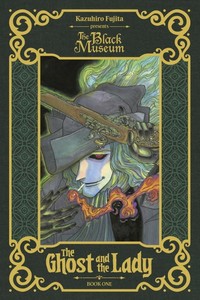Review
by Rebecca Silverman,The Ghost and the Lady
GN 1 - [Hardcover]
| Synopsis: |  |
||
In the earliest years of the twentieth century, Scotland Yard's infamous Black Museum is curated by a lone woman. One day a strange visitor appears, asking about a relic of the Crimean War: two bullets fused together, supposedly by hitting each other head-on after being fired. No sooner does she show her visitor the item than an even stranger guest appears – the ghost of an 18th-century duelist known as The Ghost in Grey, who claims to know the truth behind the bullets. Grey, as he asks to be called, had an encounter with a young Florence Nightingale before she left for the Crimean War, and promises to tell the curator his story... |
|||
| Review: | |||
This is a manga about things that really happened, wrapped in a layer of things that didn't. In other words, it's historical fantasy – fictionalized historical events with a touch of the supernatural. The Ghost and the Lady is the second of Kazuhiro Fujita's stand-alone stories based in Scotland Yard's Black Museum, a private repository of crime artifacts from the worst, most baffling, or most famous of London police's cases. The first book in this series, which deals with the early Victorian myth of Spring-Heeled Jack, has not been licensed in English, and if it's anything like The Ghost and the Lady, that's a real shame. The story takes place in both 1900(ish) and the 1850s. When a curator of the Black Museum (fictional, unless she's meant to be a version of P.C. Randall, who unofficially filled that role) is visited by the ghost of an 18th century duelist calling himself Grey, he begins to tell her the true story of one item in the museum's collection. As it turns out, Grey, who perished in 1763, haunted Florence Nightingale from the 1850s on – at her request. Young Florence, dismayed by her parents' refusal to allow her to pursue a nursing career, sought out Grey to ask him to kill her. He said that he would, but only when she had fallen into the depths of despair, in order to make her death more dramatic. Since that hadn't happened yet, Grey accompanied Florence to Crimea when she famously brought her nurses there to tend to the wounded soldiers, setting himself up as her reluctant guardian spirit, seen only by the Lady with the Lamp herself. But why does Florence Nightingale need protection? Because not only can she see ghosts, she can also see “eidolons,” spirits that serve as the manifestations of people's rage and unhappiness. Eidolons (from a Greek term that can simply mean “ghost”) can also attack each other; when you feel emotionally exhausted after a fight with someone, that's because your eidolon has been defeated. Florence's eidolon was actively attacking her, so Grey destroyed it, leaving her spirit vulnerable, so he essentially takes on that role for her. This first of two volumes is equal parts historical fiction about the Crimean War and Nightingale's role in reforming nursing and a dark fantasy about Grey, eidolons, and his own mysterious past. It's clear that Fujita has done his research, as historical costumes change appropriately depending on the time period, the rules of dueling are correctly laid out, and great care is taken to follow the written record wherever possible. The Crimean War parts of the story are very reminiscent of the PBS series Mercy Street, while Grey's past has the flavor of the dramas he so loves, especially those of the mid-18th century. The sections in the actual museum are the least serious, but they can serve as welcome breathers from the rest of the tale. Fujita's artwork is very busy, although he uses very little grey space. It has a flavor of 1970s manga to it (not surprising, since he's one of the older mangaka being translated at the moment), but this works well to capture the fervor of Florence's work and the horrible confusion of the battlefield. The eidolons look a little like stands from JoJo's Bizarre Adventure, but not so much that they're distracting. In fact, some of the odder details, such as Florence's eidolon-less spirit being drawn as her naked to show her vulnerability, or the barely-there-yet-all-too-human depiction of Grey, really make the art stand out in a positive way. It can get overwhelming, but overall it works with the story being told. That Kodansha has made this one of their hardcover releases adds to the reading experience, not just because of the color pages and the essay about Nightingale by Zack Davisson, but also in hardcover's ability to add weight and a feeling of classiness to the volume in keeping with its 19th-century story. Historical fiction enthusiasts, even those who prefer not to have ghosts in their stories, should definitely give this book a chance. With the appearances of real people from the Chevalier d'Éon to William Howard Russell to medical history (including how Florence Nightingale still believed that cholera was caused by “miasma”), the story is rich with details while remaining emotionally engaging. The Ghost and the Lady is well worth reading, and we'll have to hope that the volume about Spring-Heeled Jack will eventually see an English release as well. |
|
The views and opinions expressed in this article are solely those of the author(s) and do not necessarily represent the views of Anime News Network, its employees, owners, or sponsors.
|
| Grade: | |||
Overall : A-
Story : A-
Art : B
+ Good historical details, Grey becomes increasingly interesting and sympathetic as the story goes on, art makes some strong choices... |
|||
| discuss this in the forum (5 posts) | | |||
| Production Info: | ||
|
Full encyclopedia details about Release information about |
||